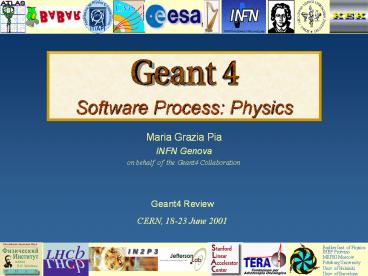Software Process: Physics - PowerPoint PPT Presentation
Title:
Software Process: Physics
Description:
Univ. of Barcelona. Geant4 Review. CERN, 18-23 June 2001. Maria Grazia Pia, INFN Genova ... Example of traceability map. Maria Grazia Pia, INFN Genova. SPI ... – PowerPoint PPT presentation
Number of Views:32
Avg rating:3.0/5.0
Title: Software Process: Physics
1
Software Process Physics
- Maria Grazia Pia
- INFN Genova
- on behalf of the Geant4 Collaboration
Geant4 Review CERN, 18-23 June 2001
Budker Inst. of Physics IHEP Protvino MEPHI
Moscow Pittsburg University Univ. of
Helsinki Univ. of Barcelona
2
Outline
- User Requirements
- Capture
- Specification, Analysis, Maintenance
- Approval, prioritisation
- OOAD
- Testing and validation
- Traceability
- SPI
- Various methodologies followed by the Physics WGs
- Adapted to the scope of each WG, its management
etc. - Also adapted to the user communities addressed
- A rigorous software process is applied
- in support of a better quality of the software
- especially relevant in the physics domain
3
UR capture
Various methodologies adopted
- Elicitation through interviews and surveys
- Useful to ensure that UR are complete and there
is wide agreement - Joint workshops with user groups
- Direct requests from users to WG coordinators or
members - Use cases
- Analysis of existing Monte Carlo codes
- Study of past and current experiments
- Prototyping
- Useful especially if requirements are unclear or
incomplete - Prototype based on tentative requirements, then
explore what is really wanted
- Not only functional requirements, users also ask
for - Documentation
- Proof of validation of the physics models and
their implementation - Examples of application in real-life set-ups
- The requirements derive from many sources, in
diverse domains - HEP, astrophysics, space, medical etc.
User requirements evolve and we should be able
to cope with their evolution!
4
UR specification, analysis and maintenance
An example
- UR 4.1 The user shall be able to simulate
polarised Compton scattering. - Need Essential
- Priority Needed by end 2001
- Stability Stable
- Source INFN-Argentinian telescope, UNH
- Clarity Clear
- Verifiability To be verified
Posted on the WG web site
Other methodologies adopted eg. Hadronic
Physics UR described in a publication
5
UR approval, prioritisation
Internal requirements
Collaboration-wide requirements
- Affect a single physics WG, not other
categories - Handled within the WG
- WG coordinator decides
- Decided in WG meetings
- Informal discussions within the WG
- Then reported to the TSB
- Usually as part of the WG plans for a Geant4
release - Recorded
- In WG public documents
- In WG internal documents
- In WG coordinators private documents
- Affect more than one class category, or relevant
architectural issues - Discussed in the TSB
- Recorded in the TSB minutes
6
OOAD
Spiral approach
The life-cycle model adopted for most domains in
Geant4 is both iterative and incremental ?
especially relevant in the physics domain!
Booch methodology for OOAD
- has been chosen as the common language for
documentation of designs and internal design
reviews - old documents in Booch notation are being
progressively updated and converted to UML
UML notation
- extensively used for the initial generation of
design documents - regularly used as part of the software
life-cycle by some WGs - where required, also for reverse engineering
- (Hadronic Physics, Standard EM, LowE EM initially)
Rational Rose CASE tool
7
Design process
Framework functional requirements are obtained
through use-case analysis Framework components
are found through grouping use-cases into
independent bundles
Keep abstractions general and implement in
framework interfaces
An example of OOAD in the physics domain
A Russian dolls approach to framework design
Address more specific use-cases in specialized
frameworks, that are implementing the interfaces
of the more general frameworks
8
Testing QA
Posted on the WG web site
- Various levels of testing
- Unit testing
- Cluster testing
- System/integration testing
- Acceptance testing
- Physics validation
- Other tools and methods to improve quality
- Automated code checking (Code Wizard)
- Code reviews
- Defect analysis and prevention
Documentation of procedures, essential to a
rigorous software process
9
Unit tests
Examples
10
Validation
- Comparison with experimental data
- At various levels details of physics models and
global features
Some examples
Shower profile
Multiple scattering
p elastic scattering on hydrogen
11
Collaboration with user groups in testing
Pixel ionisation chamber Relative dose in water
Independent validation of physics models and
implementation
INFN Torino
Some examples
Photon attenuation coefficient in water
LIP Portuguese Oncological Institute
Italian National Institute for Cancer Research
12
Traceability
- Traceability between
- Requirements
- Design
- Implementation
- Tests
?
Traceability process
One of the objectives of the SPI programme in
progress
Already fully implemented and documented in one
of the Physics WGs In progress in other
WGs Emphasis at the Geant4 Workshop in July
13
Example of traceability map
14
SPI
- Improvements motivated by the assessment in 2000
- focus on design and QA
- Tailor Geant4-wide processes to the specific
context of WGs, or even of projects - Aim a continuously improving software process
15
Relevant activities in 1999-2000
- Collection, specification and analysis of new
requirements - Maintenance of WG URD
- (for WGs having specific URD)
User Requirements
The maintenance of the general Geant4 URD is part
of the SPI in progress
- Design iterations
- OOAD cycles for new features
- Move to UML notation
OOAD
- New tests
- Extension of coverage of existing tests
- Collaboration with users in validation
- Design and code reviews
Testing QA
SPI
- Traceability
- Internal training to SPI































